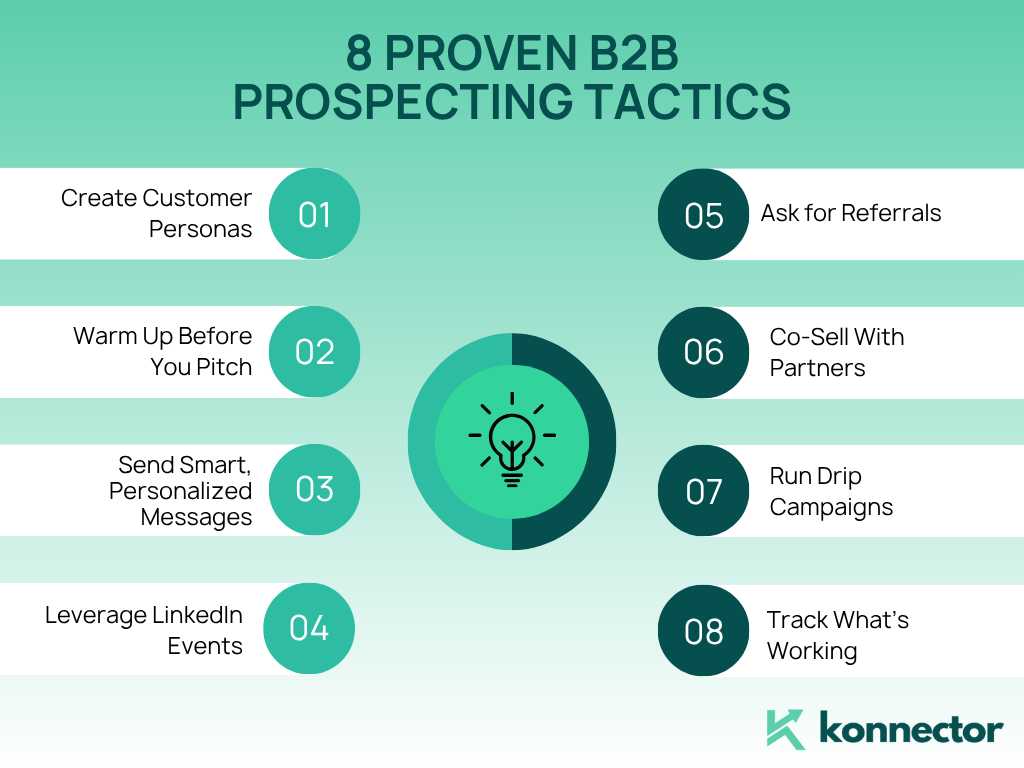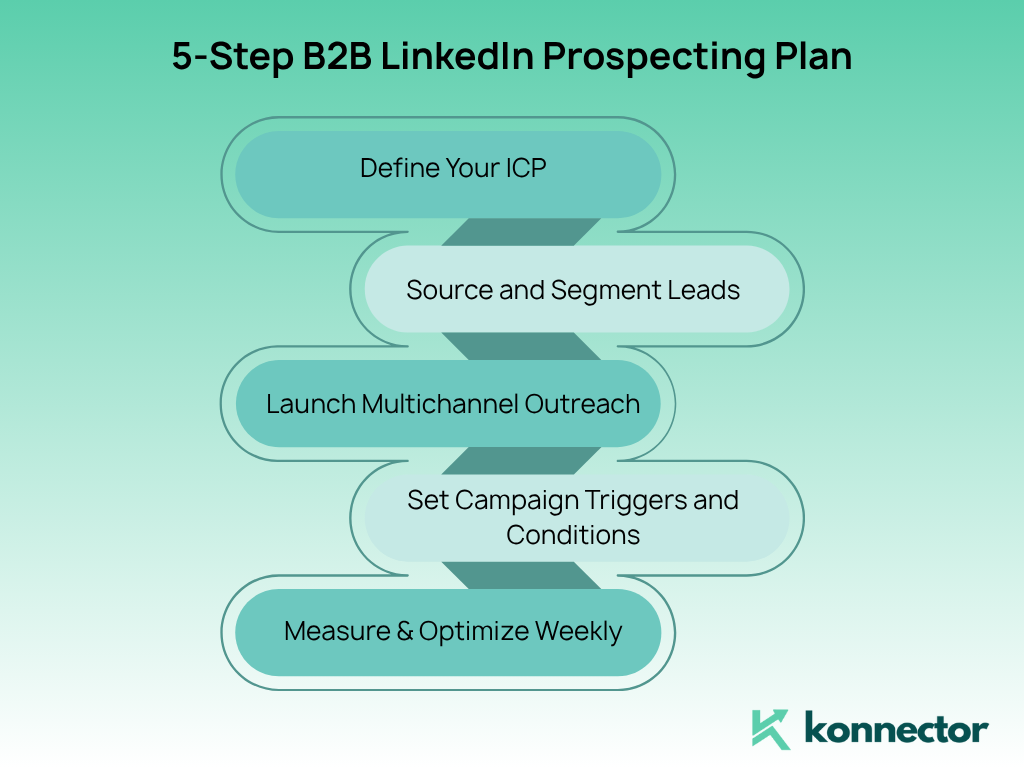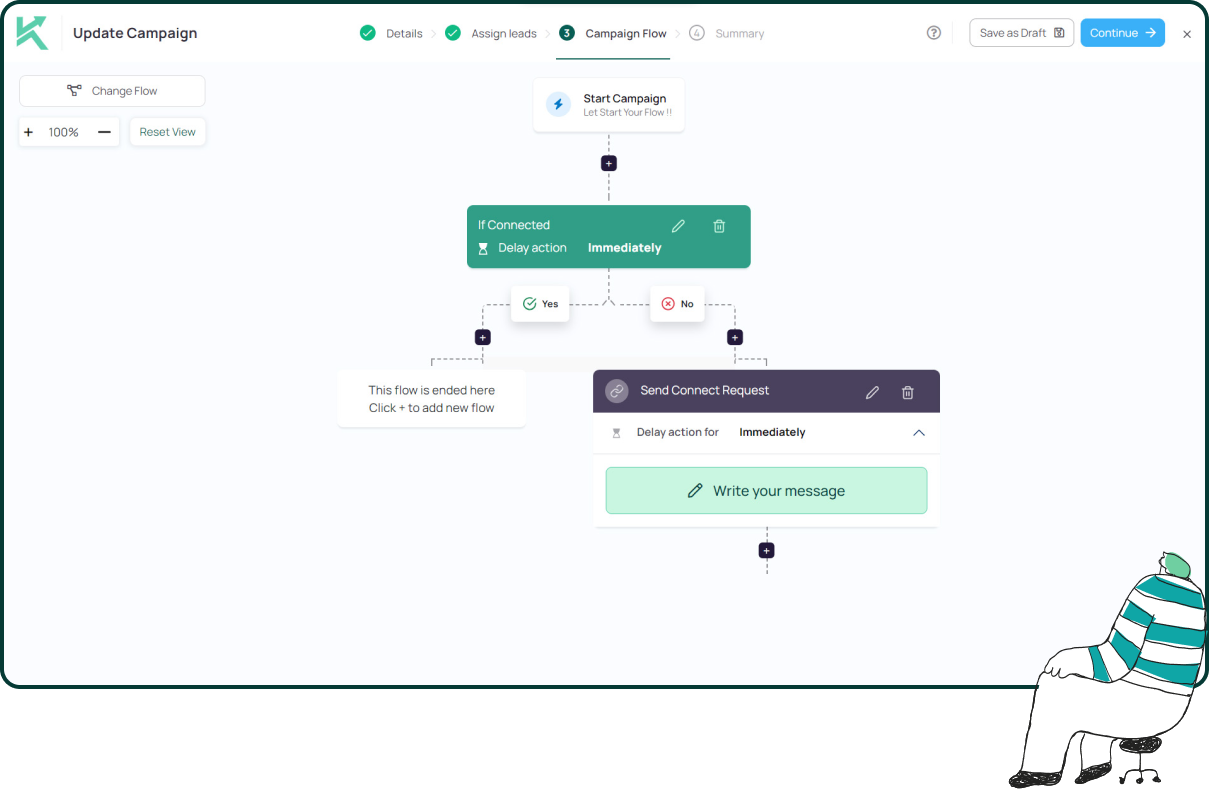B2B LinkedIn Prospecting Plan: Tools, Tactics & Timelines
In B2B sales, the lifeblood of your pipeline is consistent, high-quality prospecting. But between busy calendars, long sales cycles, and increasing buyer resistance, keeping your prospecting engine running can feel overwhelming. That’s where having a strategic, automated prospecting plan makes all the difference.
This guide walks you through a scalable B2B prospecting process—what it is, how it works, and the exact tools and timelines you can use to get real results on LinkedIn.
What Is a B2B Prospecting Plan?
A prospecting plan is a repeatable framework to identify, connect, and engage with potential customers. In a B2B context—especially on LinkedIn—it includes targeted research, multichannel outreach, and a structured follow-up system.
Think of it as your blueprint for turning cold contacts into warm conversations and pipeline opportunities. The right plan removes guesswork and lets you focus on what moves deals forward.
Why LinkedIn Is the Best Prospecting Channel for B2B
With over 1 billion professionals, LinkedIn is built for business. You can filter prospects by job title, industry, location, company size, and more—making it a goldmine for precision outreach.
LinkedIn users are typically decision-makers or influencers within their companies. You’re not just reaching a broad audience; you’re reaching the right one. Combine that with social proof (mutual connections, content engagement), and it becomes a powerful outbound channel.
The 5 Ps of B2B Prospecting Success
- Purpose: Define who you’re targeting and what success looks like (booked calls, replies, connections).
- Preparation: Research your ICP, gather insights, and build segmented lead lists.
- Personalization: Go beyond “Hi {First Name}.” Tailor messages based on role, company news, or mutual connections.
- Perseverance: Most prospects won’t respond to the first message. Stay consistent with value-driven follow-ups.
- Practice: Refine your scripts, experiment with tone, and adapt based on data.

Tools You Need for LinkedIn Prospecting
You’ve got the plan. Now it’s time to power it up. The right tools can transform a manual, time-consuming prospecting process into a scalable, data-driven system. Whether you’re sourcing leads, running campaigns, or tracking results, here are the must-haves to streamline your LinkedIn outreach:

- Lead Extraction Tools: Automate the process of pulling leads from LinkedIn searches, events, groups, and posts.
- Email + LinkedIn Sequences: Use automation tools to run drip campaigns that blend emails with LinkedIn messages.
- Email Verification: Clean your list to boost email deliverability and reduce bounce rates.
- CRM Integration: Sync all activities with your CRM for visibility and tracking.
- Analytics Dashboards: Track key metrics like connection rates, open rates, and conversion to demo.
8 Proven B2B Prospecting Tactics
Even the best strategy falls flat without the right execution. Once your target audience and outreach channels are defined, it’s time to put your plan into action.
These tried-and-tested B2B prospecting tactics will help you get more responses, start better conversations, and drive more pipeline—without sounding robotic or salesy.

- Create Customer Personas: Build detailed profiles based on job function, goals, and common objections.
- Warm Up Before You Pitch: Engage with posts, leave thoughtful comments, or like updates before you send a connection request.
- Send Smart, Personalized Messages: Use AI-powered templates but customize your first line and CTA.
- Leverage LinkedIn Events: Join and scrape attendees of industry webinars or summits.
- Ask for Referrals: After a deal closes, ask who else might benefit from your product.
- Co-Sell With Partners: Team up with complementary service providers to cross-refer leads.
- Run Drip Campaigns: Automate multi-step sequences with delays and if/then logic.
- Track What’s Working: Review campaign performance weekly—tweak subject lines, CTAs, and send timings.
LinkedIn vs. Email Prospecting: Which One Wins?
Both channels play key roles in modern B2B outreach, but they serve slightly different purposes. Here’s a side-by-side comparison:
| Criteria | ||
|---|---|---|
| Response Rate | Higher (10–30%) if personalized well | Moderate (3–15%), depends on list quality |
| Tone | Conversational, social | Formal, direct |
| Best Used For | Early-stage relationship building | Sharing resources or booking demos |
| Automation | Limited by LinkedIn rules | Highly flexible with tools like Mailshake, Lemlist, HubSpot |
Pro tip: Use both together in your outreach sequence. Engage on LinkedIn first, follow up via email, and then reconnect on LinkedIn with a message like “Hey, just sent something useful to your inbox too!”
5-Step B2B LinkedIn Prospecting Plan
- Define Your ICP: Focus on firmographics (industry, size) and intent signals (recent funding, hiring).
- Source and Segment Leads: Pull lists from Sales Navigator, LinkedIn groups, or event attendee data.
- Launch Multichannel Outreach: Set up a blend of LinkedIn messages, email nudges, and profile views.
- Set Campaign Triggers and Conditions: Automate follow-ups based on opens, profile views, or connection status.
- Measure & Optimize Weekly: Analyze response rates, booked meetings, and source/channel performance.

Read more—> Top 10 Tips for Better Outreach on LinkedIn
Sample Outreach Sequence (7-Day Plan)

- Day 1: View profile + follow
- Day 2: Like or comment on a post
- Day 3: Send personalized connection request
- Day 5: Message #1 with value (no pitch)
- Day 7: Message #2 with soft CTA (e.g., “open to a quick chat?”)
Prospecting Timelines to Follow

- Week 1–2: Research, define ICP, build prospect lists (at least 300–500 high-quality leads).
- Week 3–4: Start drip campaigns and monitor early engagement.
- Week 5–6: Refine messaging, double down on what’s working, and rotate in fresh leads.
- Week 7 onward: Use CRM or automation analytics to double conversion from warm leads.
Read more—-> LinkedIn Outreach at Scale: Automate Without Losing Engagement
Cost Per Lead & ROI
Depending on industry, B2B lead costs range from €80–€800. LinkedIn automation tools can bring this down significantly by saving time and improving targeting. Measure ROI using metrics like:
- Lead-to-meeting rate
- Connection acceptance rate
- Response rate (LinkedIn + email combined)
- Revenue per campaign vs. cost of acquisition
Efficiency beats volume. It’s not about reaching more people—it’s about reaching the right people at the right time with the right message
Final Thoughts
There’s no one-size-fits-all formula for B2B LinkedIn prospecting—but with the right tools, smart sequencing, and consistent testing, you can create a pipeline machine that drives qualified leads week after week.
Start small, automate wisely, and always lead with value. Whether you’re selling SaaS, consulting, or services, LinkedIn gives you the edge—if you play it right.

11x Your LinkedIn Outreach With
Automation and Gen AI
Harness the power of LinkedIn Automation and Gen AI to amplify your reach like never before. Engage thousands of leads weekly with AI-driven comments and targeted campaigns—all from one lead-gen powerhouse platform.






